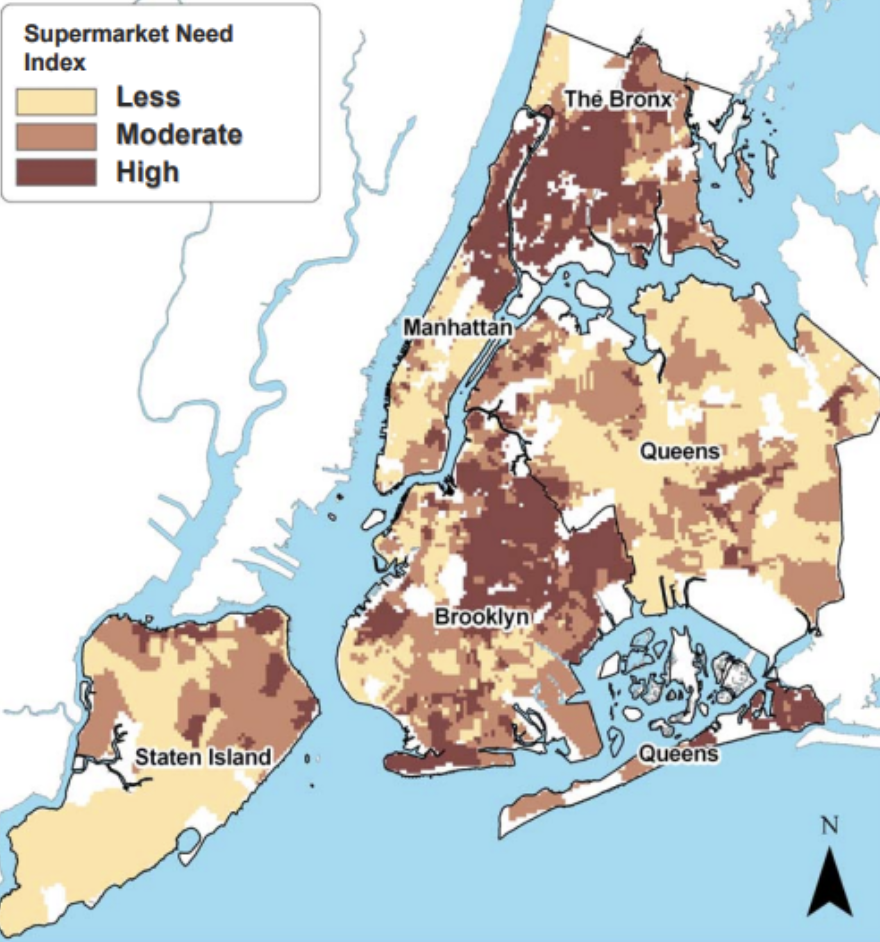What Is A Food Desert?
A food desert is a geographical area where it is difficult to buy healthy, nutritious food at an affordable price. Food deserts include areas where travel to a grocery store is difficult, and in areas where healthy food may be available, but at an unaffordable price.
New York City is among the top ten cities in the U.S. with the most or largest food deserts.
Learn more: What Are Food Deserts?
Fast Facts About Food Deserts in New York City
- Around 3 million people in New York City live in neighborhoods with low access to grocery stores (NYC Department of Planning).
- Over 700,000 people in New York City have diabetes (NYC Department of Planning).
- Roughly 40% of New York City residents experience difficulty buying food (food hardship) in a year (Columbia University 2019).
Why Are There Food Deserts In New York City?
Food deserts are a socio-economic problem that tend to occur in specific neighborhoods as a result of a lack of proper aid and investment in that neighborhood.
Food deserts are found in New York City in neighborhoods with high poverty levels. These areas have lower access to transportation, making it more difficult to get to a grocery store.
Food deserts are also disproportionately found in areas where the residents have lower levels of education and high unemployment rates. Areas with food deserts also have high rates of abandoned or vacant buildings.
Food deserts are more likely to occur in primarily Black communities in New York City. A national 2014 study showed that even in areas of equal poverty, Black communities are less likely than communities of other races to have access to grocery stores and fresh food (Bower et al. 2014).
Where Are There Food Deserts In New York City?
Areas in New York City with low-income and low-access to stores, as well as low vehicle access are food deserts.
This map provides an overview of where food deserts are located in the city of New York City and surrounding areas. Any area showing color is a food desert. These areas closely overlap with low-income areas.
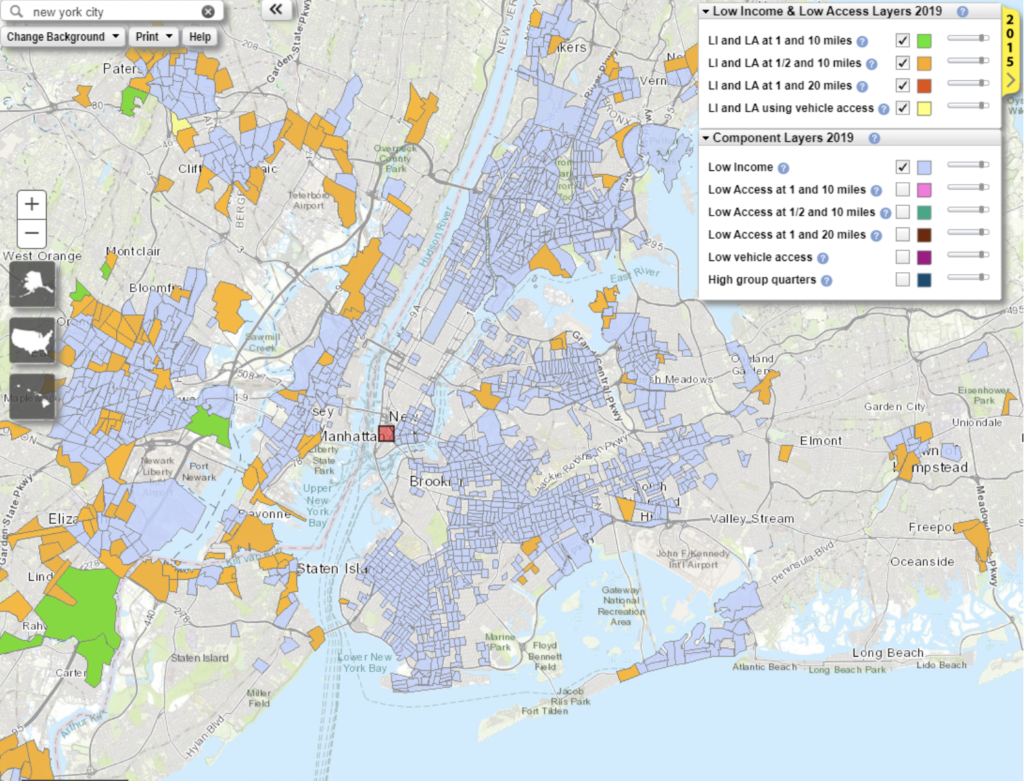
Source: USDA Food Access Research Atlas
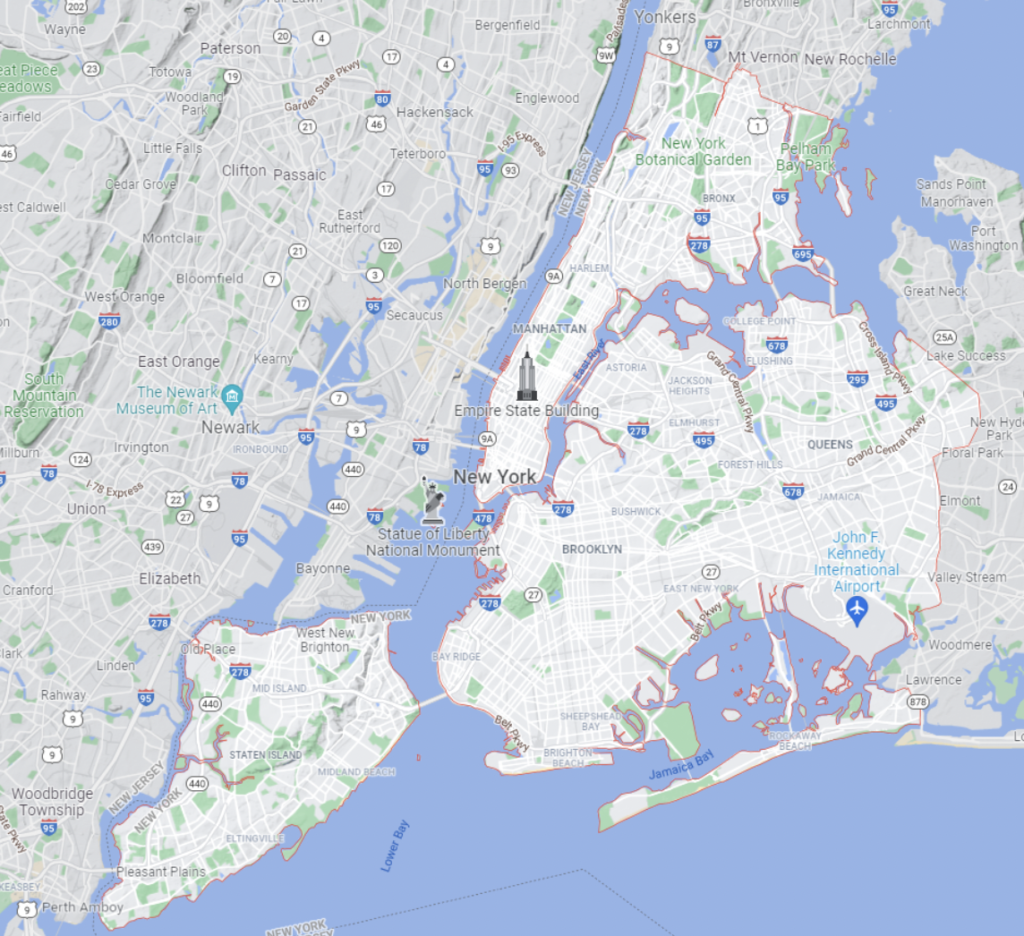
The map below provides a more zoomed-in view of food deserts in New York City by neighborhood. Areas with High Supermarket Need are food deserts.
Food deserts in New York City overlap heavily with low-income areas. Note how the dark purple areas (high poverty rates) line up with the dark brown (high need of grocery stores) in the map above.
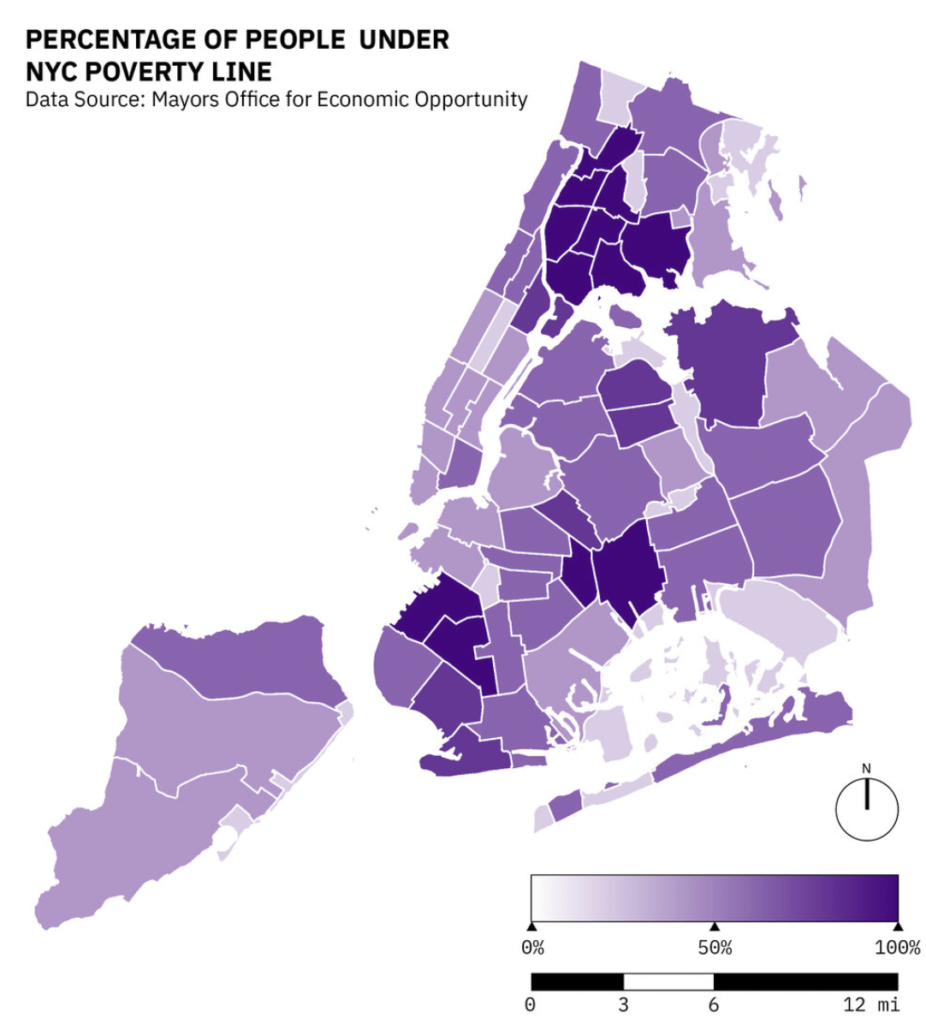
The map below shows how many families in an area are falling short on their food budgets. Areas in red indicate families experiencing high rates of food hardship. This map indicates that even if healthy food is available, it is not always affordable. Therefore even areas with higher access to grocery stores may still be considered low-income food deserts.

Additionally, areas of New York City with the highest percentage of African American residents coincide with the worst areas of food deserts (Gordon et al. 2011).
Food deserts also coincide with areas where diabetes and obesity are high. This is likely because of a limited access to healthy food.
Solutions
The first step in disrupting food deserts in New York City is researching where food deserts exist. New York City began to address this in 2008 with the completion of a study of grocery store shortages in the city.
The study compared different neighborhoods, showing the number of grocery stores per capita in each. This was compared with the city average to assess whether the area was in need of more grocery stores. Areas where the number of grocery stores per capita was less than the city capita were considered “In Need” of grocery stores.
Beyond research, multiple solutions are needed to address food deserts.
Increasing the Number of Grocery Stores
Some efforts have focused on increasing the number of grocery stores within New York City. The same 2008 study of grocery store shortages aimed to assess where new grocery stores could be built (NYC Department of Planning).
More grocery stores can help by increasing competition among grocery stores in food deserts, thereby lowering grocery costs. The rationale is that with more convenient grocery stores, people are more likely to buy healthy foods.
However, a 2017 USDA report found that financial restraints may be a greater barrier to fresh foods than proximity to grocery stores, so it is crucial to address financial instability in conjunction with increasing ease of access to grocery stores.
Increased Access To Vehicles And Other Public Transportation Systems
In addition to creating more healthy food options locally, increasing transportation options can help reduce food deserts.
One method to increase transportation to grocery stores is to build up better public transportation. This may include adding a bus stop or even creating a shuttle system within the town.
Additionally, Lyft ride sharing created the Grocery Access Program to discount the cost of rides to grocery stores. This program has been piloted successfully in Washington D.C. in 2019, and has expanded to Brooklyn since then.
Other Solutions
Other solutions that could help eliminate food deserts in New York City include:
- Financial incentives and support for neighborhood-based grocery stores and farmers markets with discounted prices
- Increased financial assistance for residents of food deserts to buy food
- Increased community gardens and urban farming. For example, this can be done on the many rooftops in NYC.
- Restrictions on where dollar stores can be, as they displace grocery stores
- Increased public health education to encourage healthy eating
Some of these solutions are already being implemented. For example, the Food Bank for New York City provides free workshops on nutrition education. There are also several community-supported agriculture (CSA) programs in the city that provide farmers market foods to New Yorkers, and accept food stamps at many stands.
Case Study: The Bronx
The Bronx is a neighborhood in New York City, separated from Manhattan by the Harlem River. The Bronx is one of the most food insecure places in the U.S., with a food insecurity rate of 37%, compared to 16.6% for the rest of New York City.

Much of the Bronx is considered a food desert. This is due to low access to grocery stores, low access to transportation and low-incomes.
While there are a number of delis and bodegas (small corner stores), these are less likely than grocery stores to carry fresh food. In fact, there are far more bodegas in the Bronx than there are grocery stores.
Many areas of the Bronx experiencing food insecurity follow the classic characteristics of where food deserts are most commonly found. Compared to the rest of the New York City metropolitan area, areas of the Bronx have a lower education level, lower income, and a larger non-white community.
- Only 20.1% of Bronx residents have a Bachelor’s Degree, compared to 38.1% of people in New York City as a whole.
- Additionally, the median income in the Bronx is around $40,000, while the median income in New York City as a whole is around $64,000.
- 43.6% of Bronx residents are Black compared to 24.3% of the people in New York City.
- 56.4 Bronx residents are Hispanic compared to 29.1% of people in New York City.
- 31% of the Bronx population receives SNAP benefits.
(Data from the U.S. Census).
Many solutions have been suggested to increase Bronx residents’ access to healthy food. One example is to increase the number of farmers markets that accept EBTs, a card that allows Supplemental Nutrition Assistance Program (SNAP food stamps) customers to pay electronically.
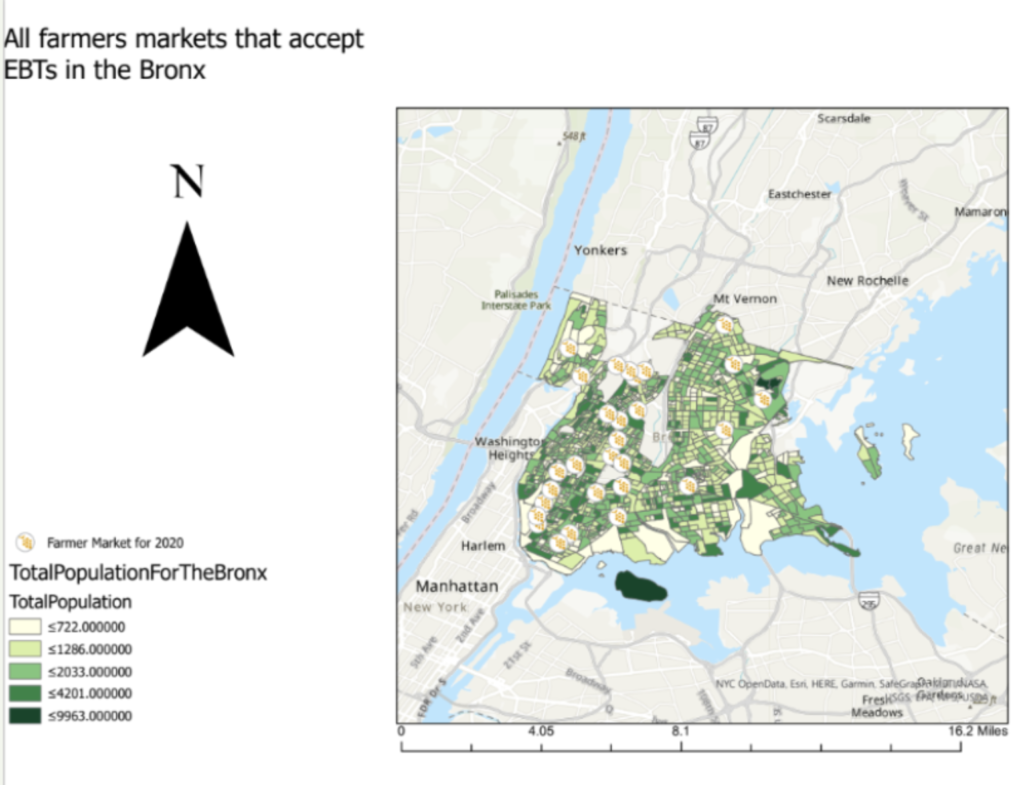
Note that there are farmers markets in the Bronx (each circular white bubble), but they are not widespread.
Some Bronx residents rely on farmers markets for fresh vegetables, stating that the local supermarkets are inconvenient, expensive and don’t carry fresh foods (Yan 2018).
The Learn It Grow It Eat It program, run by GrowNYC, provides a weekly farmers market in the Bronx that aims to improve the eating habits and nutrition education of youth in the community.
While farmers markets are a step in the right direction, solutions beyond creating more farmers markets are necessary to truly disrupt the food desert.
